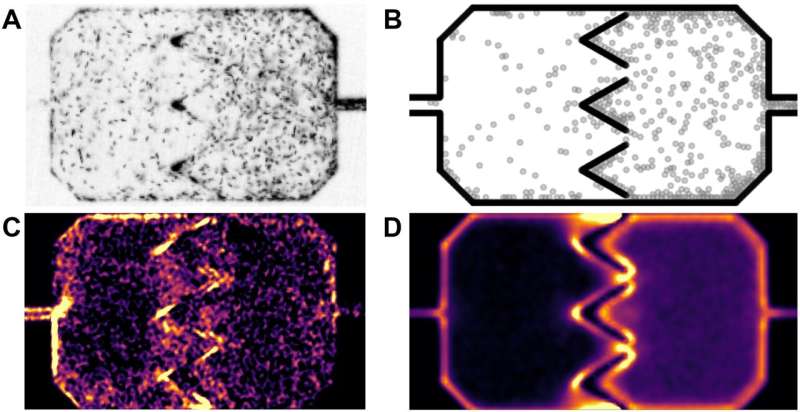December 12, 2022 feature
A numerical protocol to estimate local entropy production

In physics, equilibrium is a state in which a system's motion and internal energy do not change over time. Videos of systems in equilibrium would look exactly the same if they were watched in their normal chronological progression or backwards. This symmetry means that a system has an entropy production rate equal to zero.
A physical phenomenon occurring outside of equilibrium, on the other hand, would look different if it were to be watched chronologically or backwards. The entropy production rate of these non-equilibrium phenomena would thus be greater than zero.
Past studies have introduced several methods to calculate the entropy production rate of simple systems outside of equilibrium. Yet a reliable method to measure this parameter in experimental settings and in more complex systems has not yet been identified.
Researchers at Technion (Israel Institute of Technology), New York University and Princeton University have recently introduced a numerical method that can be used to derive local measurements of the entropy production rate. This method, introduced in a paper published in Physical Review Letters, entails the comparison of trajectories of particles in chronological and time-reversed simulations.
"We have been studying non-equilibrium phenomena from the standpoint of information theory, where our main interest has been measuring and assessing the importance of Shannon entropy of systems far from equilibrium," Dov Levine, one of the researchers who carried out the study, told Phys.org.
"This work is a natural extension of that, in that the essential feature of non-equilibrium systems is that they break time reversal invariance (that is, movies look different run forward and backward)."
The technique devised by Ro, Guo, and their collaborators essentially entails the analysis of videos showing the random movement of self-propelled particles in space. This movement is represented in a grid, where each point on the grid is assigned an integer number that varies in time in alignment with the movement of the particles.
Subsequently, a model compares the representation of movement sequences in chronological order to those occurring in time-reversed order, to determine the number of shared patterns between the two. These shared patterns are then used to estimate the entropy production rate of the system.
"We were able to measure entropy production (which is a direct consequence of the breaking of time reversal invariance) by analyzing a movie (i.e., simulation) of an experiment," Levine said. "Motivated by an earlier work of the group of Mike Cates and his collaborators in Paris, we studied the space dependence of this quantity (i.e., whether it is larger near the walls or in regions with a high density of particles). We then adapted an information theory method called 'cross-parsing,' invented by Neri Merhav and Jacob Ziv, to measure a quantity directly related to entropy production."
To demonstrate the effectiveness of their method, the researchers estimated the local entropy production of active Brownian particles undergoing what is known as "motility-induced phase separation" (i.e., a process in which the particles separate into a fluid phase of fast moving particles, and clusters of slow movers), using numerical simulations. They also used it to estimate the entropy production rate of live E.coli bacteria, which were directed into a specific region using a funnel.
Their initial results highlight the potential of this computational protocol for measuring the entropy production rate of non-equilibrium phenomena in both simulations and lab experiments. In the future, their proposed approach could open new and exciting possibilities for the study of a broad range of complex dynamic systems, including bacteria, live tissue, cells, vortices, traffic or other collective behavior, and even cosmological phenomena.
"We showed that there is a connection between the amount of work that can be extracted from a region in a system and the amount of entropy production in this region," Levine said. "Equilibrium systems do not produce entropy and cannot do useful work, while systems far from equilibrium can. We are now trying to make the connection between extractable work and entropy production more precise."
More information: Sunghan Ro et al, Model-Free Measurement of Local Entropy Production and Extractable Work in Active Matter, Physical Review Letters (2022). DOI: 10.1103/PhysRevLett.129.220601
Journal information: Physical Review Letters
© 2022 Science X Network




















